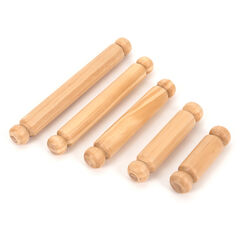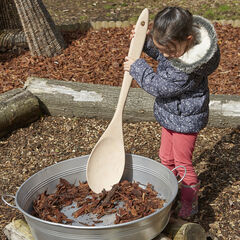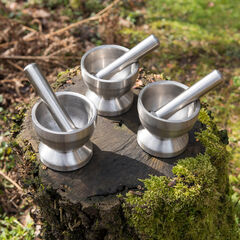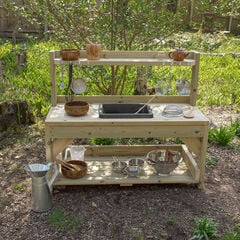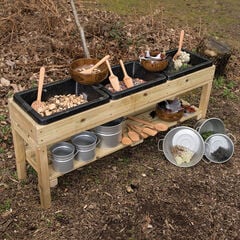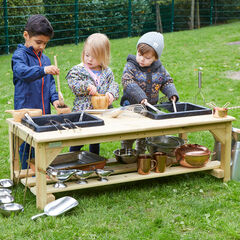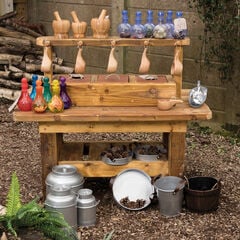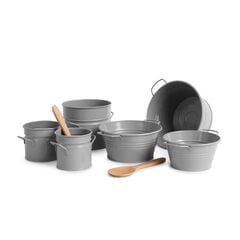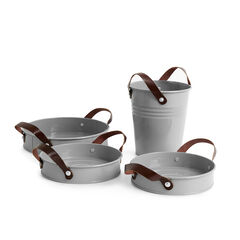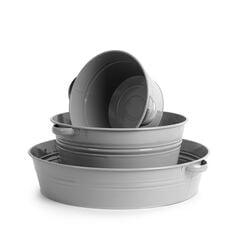Playing with mud:
Mud pies come from the love of playing with mud. Mud can provide brilliant sensory experiences for children and is an open-ended, inexpensive, natural material. Playing with mud provides so many learning opportunities, from the gross motor skill benefits of pulling on wellies and squelching in it, to the fine motor development which can be gained whilst patting and mixing it with hands and fingers. Children can experiment, become artists and even chefs or bakers! After all, who wouldn’t want to try some scrumptious mud pies!?
A very popular muddy activity is making mud pies and whilst ‘cooking’ and ‘baking’ with mud, children are engaging in role play. This rich, child-initiated play is often collaborative. Children can develop their social and communication skills as they recreate real life scenarios and extend these using the freedom of their imaginations.
Making mud pies:
Set children off on a search for their ingredients. You may wish to offer this as a child-led activity or provide children with the list of ingredients and encourage them to read and tick each one off. Provide baskets, buckets or other containers for children to collect their ingredients into.
As you experiment making mud pies with children, you will come up with your own unique recipes together. Certainly encourage children to come up with their own recipes. You can support them by writing down the ingredients they tell you as well as encouraging emergent writers to have a go at writing their recipe by themselves.
The mud pie recipe below is a great start. Use a variety of different natural materials such as flower petals, grass, leaves, sand, shells and pebbles, some of which will make the perfect decorations to go on top of your mud cakes or pies. Sticks, twigs and bark will add texture to your mud pies- just as chocolate chips or fruits do to real ones! Grass and moss can also act as a layer of icing to evenly spread over the layer of mud mixture.
As well as all of the learning opportunities and enjoyable ‘in the moment’ experience, making mud pies is, of course, the perfect stepping stone for real baking and cooking with children.
When providing children with instructions, it is important to keep these as simple as possible, particularly for those who are beginning to read and will be eager to have a go. Below is a simple and clear mud pie recipe which children can easily follow, either with guidance or by having a go at reading by themselves.
Mud pies recipe:
Ingredients:
- Mud
- Bark
- Grass
- Jug of water
Decorations:
- Sand for sprinkling
- Flower petals
- Leaves
Utensils:
- 1 cup
- 1 big bowl or metal containers – use these giant ones for group tasks
- 1 big spoon
- 1 cake tin
- Bun cases
- Mashers
- Wooden spoon
- Whisks
- Pestle and Mortars
Method:
- Put 6 big spoons of mud into the bowl.
- Pour water into the cup.
- Pour the cup of water into the bowl of mud.
- Mix.
- Add 2 spoons of bark.
- Mix.
- Add 4 spoons of grass.
- Mix.
- Pour the mud mixture into the cake tin.
- Decorate with leaves and petals.
- Sprinkle sand on the top.
Make sure you remind younger children not to try to taste their mud pies – even though these beautiful looking mud buns look tasty!
Baking through play
Making a mud pie provides so many learning opportunities just like real baking and cooking does. Yes, it is important for children to have real life baking and cooking opportunities, but doing this through play allows children to firstly make sense of this real life scenario.
Baking or cooking through play allows children to take their time, experiment, change what they are doing and test things out. It allows them to develop understanding in a way that is less constrained by health and safety rules, the use of new kitchen utensils or following of strict recipes and waiting times! All of these new concepts will be easier to comprehend once they have been introduced to them through play.
With thanks to Angelica Celinska for writing this blog. Angelica has 10 years of experience working in the Early Years and Primary sector with a Masters in Early Years Education from the Institute of Education, University College London (UCL).







